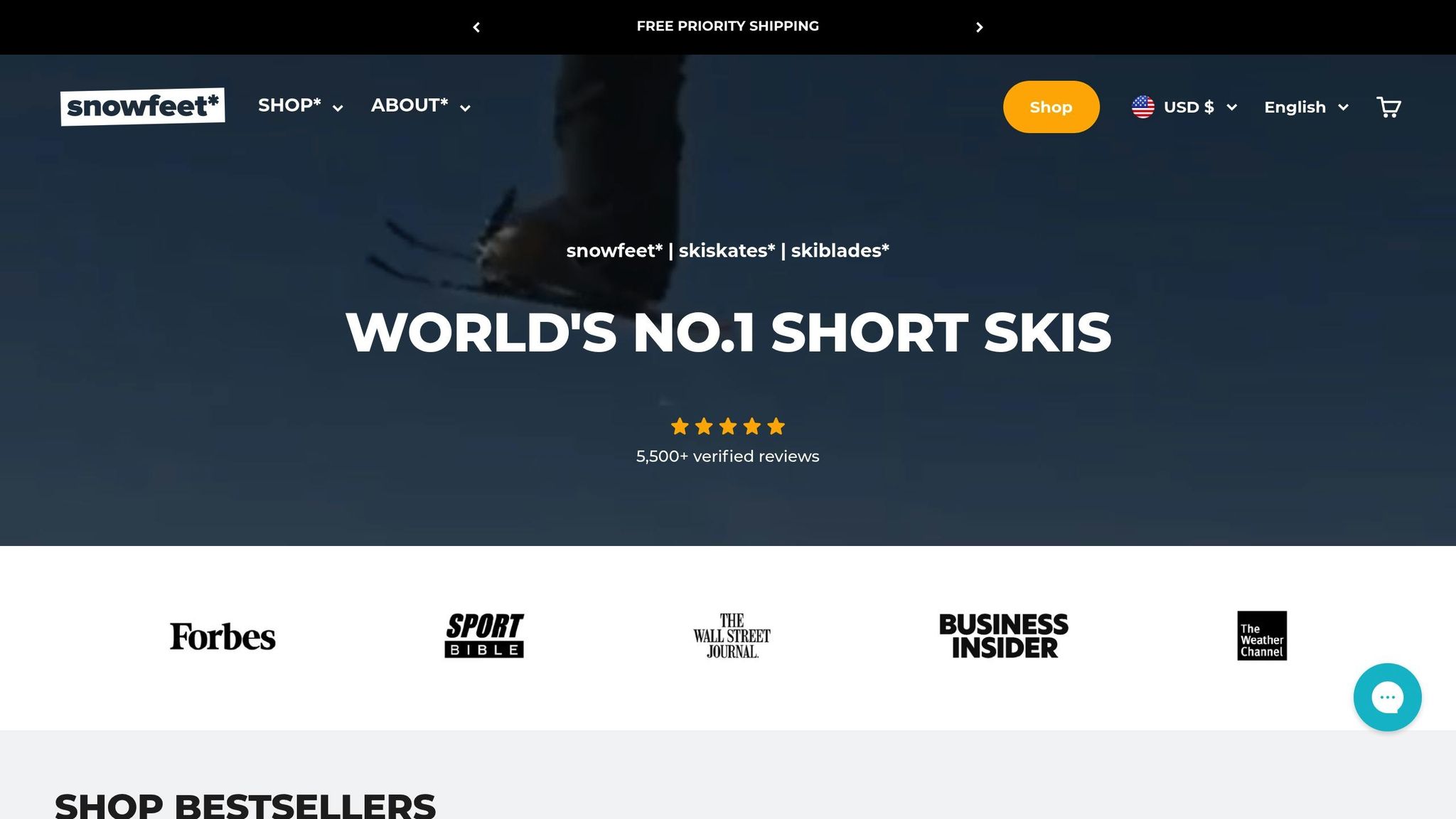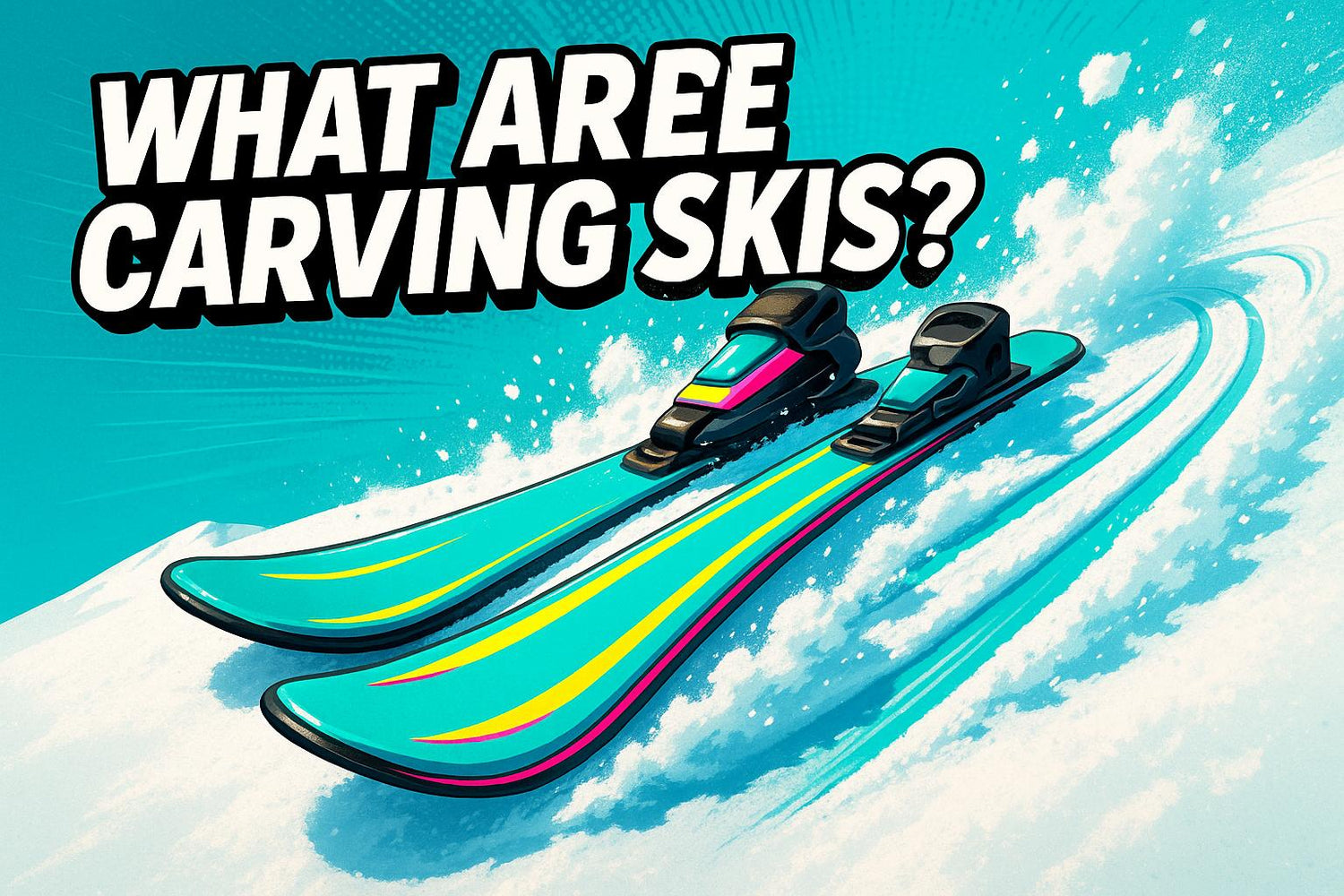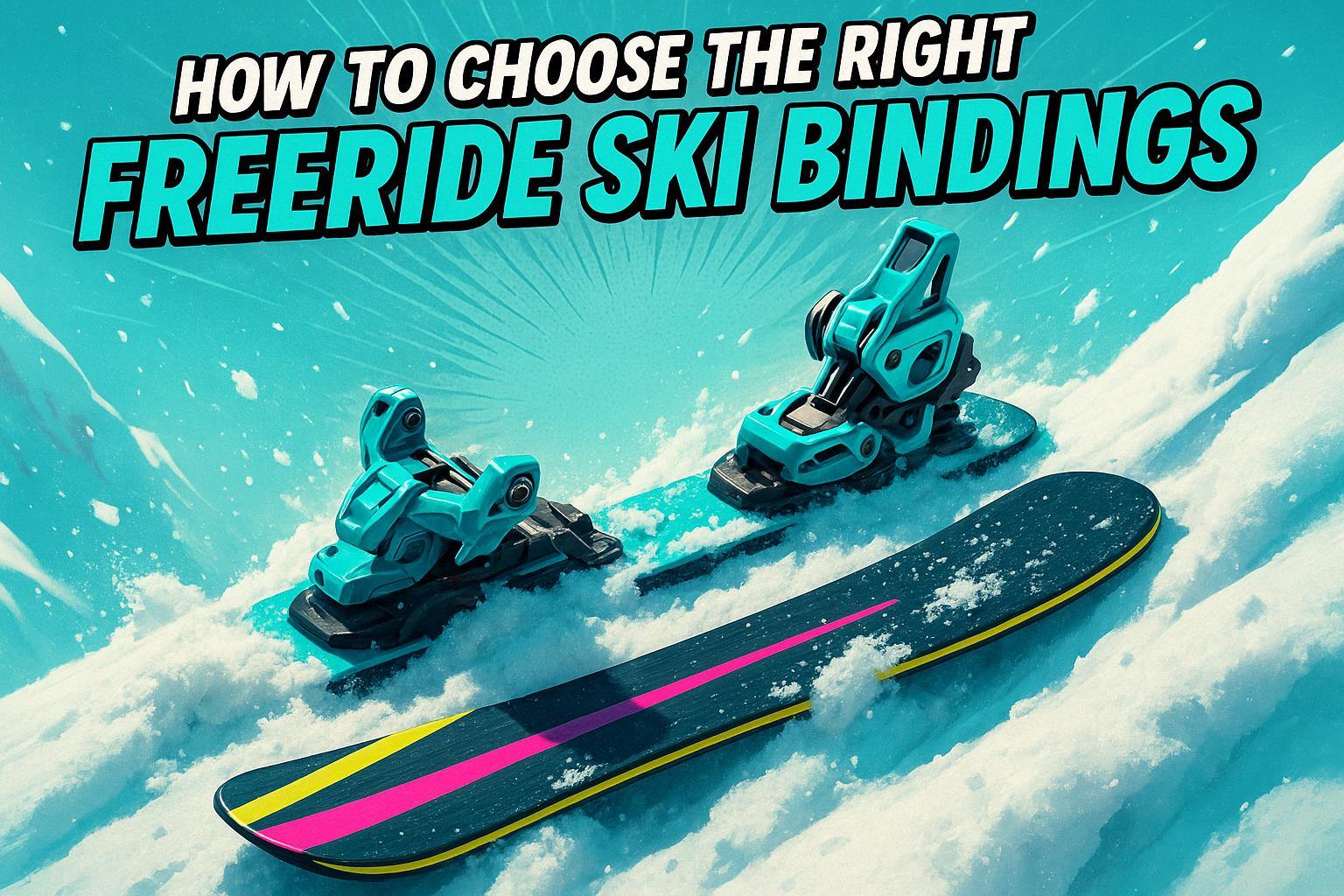Carving skis are designed for precision, speed, and clean turns on groomed slopes. Their narrow waist (65–80 mm) and pronounced sidecuts make them perfect for skiers who love sharp, controlled arcs. But they’re not for everyone - if you’re into mixed terrain or off-piste adventures, these might not be your best bet.
Who are they for?
- Intermediate to advanced skiers who enjoy groomed runs.
- Speed lovers who prioritize edge control and stability.
Who should skip them?
- Beginners or casual skiers still building confidence.
- Those who prefer powder, moguls, or varied terrains.
If carving skis sound too specialized, newer options like Snowfeet* products offer a more flexible and accessible way to enjoy winter sports. They’re lightweight, portable, and work with regular boots - perfect for quick snow fun without the steep learning curve or hefty price tag of traditional ski setups.
Mastering the Turn: What is Ski Carving? And how to Improve your Skiing
Carving Ski Design and Features
To understand why carving skis are a go-to choice for certain skiers, it's helpful to break down their design and how these features set them apart - especially when compared to alternatives like Snowfeet*.
Main Features of Carving Skis
Carving skis are all about precision and control, making them ideal for groomed runs. Their narrow waist, usually between 65 and 80 mm, allows them to cut through hard-packed snow with ease.
One standout feature is their pronounced sidecut, which creates a smaller turning radius. This design makes initiating and controlling turns feel almost effortless. They also have a stiffer flex compared to all-mountain skis, which enhances energy transfer for sharper, quicker responses.
Most carving skis come with a traditional camber profile. When laid flat, the ski arches upward in the middle, which improves edge grip and ensures steady contact with the slope, especially on hard snow. Many models also include a reinforced core, often with metal layers and heavier wood, to boost performance on groomed trails.
Turning radii vary depending on the ski's focus. For example, slalom-oriented skis have tighter radii around 10–12 meters, while race models can go beyond 18 meters.
While these design elements make carving skis great for specific conditions, they do come with trade-offs.
Benefits and Drawbacks
The thoughtful design of carving skis provides some clear perks but also limits their versatility. On groomed slopes, they shine. They let you carve clean, precise turns and offer excellent grip on icy surfaces. For skiers who value stability, speed, and precision, these skis are hard to beat.
But here's the catch: their specialized build doesn’t perform as well in softer or variable conditions, like powder or crud. In these situations, their narrow waist and stiffer flex can make them feel less forgiving and harder to manage. If you're someone who likes to ski all kinds of terrain in one day, carving skis might not be the best fit.
Lastly, these skis demand precision. They’re fantastic for advanced skiers looking to push their limits, but they can be a bit tricky - and unforgiving - for beginners or those still building confidence.
Best Users for Carving Skis
Carving skis are perfect for skiers who love the thrill of precision and speed on groomed runs. They’re designed to help you master the art of clean, arcing turns, making them a favorite for those who enjoy technical skiing.
Intermediate and Advanced Skiers
Intermediate skiers who’ve nailed basic parallel turns and want to sharpen their carving skills will find these skis a great fit. The key to enjoying carving skis is learning how to engage the edges effectively. For intermediates, models with a slightly wider waist and tip rocker offer a bit more forgiveness, making it easier to progress.
"Intermediate level skiers will find short-to-medium radius turns accessible, and advanced skiers can enjoy how fun and playful the ski is." - Josh Lynch, Colorado-based Ski Coach
Advanced skiers, on the other hand, are where carving skis truly shine. If you’re comfortable on black diamond runs and eager to push your limits in speed and precision, these skis are made for you. Look for designs with race-inspired construction that emphasize edge grip and quick responsiveness.
Once you’ve got the technique down, carving skis turn groomed runs into your playground. It’s all about precision and control, much like how Snowfeet* have brought a fresh perspective to winter sports by offering versatility across terrains.
For anyone who craves high-speed turns and technical mastery, carving skis are hard to beat.
Speed and Control Focused Skiers
If your idea of fun is carving smooth, high-speed arcs with your edges slicing through firm snow, carving skis are your dream setup. They’re built to maintain momentum through turns while giving you razor-sharp control over your speed and line.
These skis minimize friction and maximize edge grip, making them ideal for skiers who value technical precision over versatility. Their pronounced sidecut and stiff flex combine to deliver instant feedback and a responsive feel.
"This ski is a race tool with no speed limit... It's a performance-oriented ski for ripping high-speed frontside arcs." - Dave Wolf, Certified PSIA Ski Instructor and AMGA Ski Guide
Who Should Avoid Carving Skis
As amazing as carving skis are, they’re not for everyone. Here’s who might want to look elsewhere:
- Beginners: If you’re still working on basic turning and edge control, carving skis can feel unforgiving. A more forgiving all-mountain ski will help you progress faster and have more fun along the way.
- Casual skiers: If you enjoy mixing it up - hitting groomed runs in the morning, then exploring bumps, trees, or off-piste terrain later - carving skis may feel limiting. Their narrow waist and stiff build aren’t ideal for varied conditions.
- Adventure seekers: Powder hounds, mogul enthusiasts, or those who spend most of their time off-piste won’t get much joy from carving skis. Think of them as precision tools - they’re unbeatable on groomers but struggle outside their comfort zone.
"Carving skis are very useful to people who are carving addicts, carvaholics if you will." - François Pugh, Skier
In short, carving skis are for skiers who know exactly what they want: precision, speed, and control on groomed runs. However, if you’re looking for something more versatile, the next section will explore why alternatives like Snowfeet* might be worth considering for modern winter sports enthusiasts.
sbb-itb-17ade95
Carving Skis vs. Snowfeet* Products

When it comes to winter sports gear, traditional carving skis and Snowfeet* products represent two very different approaches. Carving skis are built for precision on groomed slopes, requiring specific equipment and a fair amount of skill. Snowfeet*, on the other hand, focuses on versatility, portability, and ease of use. Let’s break down the key features and differences.
Feature Comparison: Carving Skis vs. Snowfeet*
| Feature | Traditional Carving Skis | Snowfeet* Products |
|---|---|---|
| Length | 63–71 inches (160–180 cm) | 15–47 inches (38–120 cm) |
| Weight | Heavier | Much lighter |
| Terrain Focus | Best on groomed runs | Works on slopes, parks, trails, and even your backyard |
| Boot Requirement | Needs specific ski boots | Works with regular winter shoes, ski boots, or snowboard boots |
| Learning Curve | Requires significant practice | Easy to pick up - many users carve within a day |
| Portability | Needs roof racks or a ski bag | Fits in a backpack |
| Price Range | Generally more expensive | Starts around $150 |
| Storage | Needs dedicated space | Fits in a closet |
Carving skis, like those from brands such as Atomic or Head, are designed for performance on well-maintained slopes. But they come with a steep learning curve and often require a hefty investment in specialized gear. Snowfeet* products, by contrast, are designed to be simple, portable, and accessible - whether you're on a mountain or just enjoying a snowy day at the park.
Why Snowfeet* Might Be the Better Choice
Snowfeet* products stand out because they rethink what winter sports gear can be. Instead of focusing on high-performance skiing for groomed terrain, they bring a more flexible and user-friendly option to the table.
One of their biggest advantages? You don’t need special boots. Traditional carving skis require pricey ski boots, which can be a hassle to buy and break in. Snowfeet* products work with the shoes you already own - whether that’s winter boots, snowboard boots, or even regular shoes. This makes them far more convenient and budget-friendly.
Their lightweight design also makes a huge difference. Unlike traditional skis, which can feel bulky and tiring, Snowfeet* products are easy to control and won’t wear you out as quickly. Plus, they’re portable enough to toss in a backpack, so you’re not stuck lugging around a massive ski bag or dealing with roof racks.
Another big win? The learning curve. Traditional skis can take months (or even years) to master. Snowfeet* products are simple enough that many users feel confident after just a day of practice. And since they work on a variety of terrains - groomed slopes, trails, parks, or even your backyard - they’re perfect for anyone who wants to enjoy the snow without being tied to a ski resort.
Finally, there’s the cost. Between skis, boots, bindings, and poles, a traditional setup can easily run over $1,000. Snowfeet* products, starting at around $150, offer a much more accessible way to enjoy winter sports without breaking the bank.
While brands like Rossignol and Head dominate the groomed slope market, Snowfeet* is carving out a niche for people who value convenience, flexibility, and simplicity. For those looking for a fresh way to enjoy the snow, Snowfeet* products offer a practical and exciting alternative.
How to Choose the Right Snow Gear
Now that we’ve explored why Snowfeet* might be a game-changer compared to traditional skis, let’s talk about how to pick the right gear for your snowy adventures. The key? Match your gear to your experience level, the terrain you’ll tackle, and your overall goals.
Gear Selection by Skill Level
Your experience level plays a huge role in determining the best gear for you. For beginners, traditional carving skis can feel like a lot to handle - they’re long, heavy, and require plenty of practice just to master basic turns.
That’s where Snowfeet* products shine. Thanks to their shorter design, they’re much easier to control than full-length skis, making them a great option for all skill levels. If you’re just starting out, the Snowfeet* Mini Ski Skates (15 inches/38 cm) are a solid choice, especially if you’ve got some ice skating or hockey experience under your belt.
For intermediate skiers, there’s more flexibility. If you’re looking to refine your skills, the longer 99 cm Skiblades (around $490) offer a nice balance of stability and maneuverability.
Advanced skiers often lean toward traditional carving skis for peak performance on groomed trails. But here’s the twist: many seasoned skiers are finding a new kind of thrill with Snowfeet*. Their shorter length pushes you to sharpen your technique and opens the door to tricks and playful riding that longer skis just can’t deliver.
Once you’ve got your skill level covered, think about where you’ll be skiing.
Terrain and Multi-Use Factors
The type of terrain you plan to conquer is another big factor in choosing the right gear. Traditional carving skis are built for groomed slopes, but Snowfeet* products are all about versatility. Whether you’re cruising down packed runs, hitting the terrain park, or just enjoying some backyard snow, they adapt to a variety of conditions.
For groomed trails, narrow skiblades are your best bet, while wider ones handle powder better. Snowfeet* has options for both - like the POWDER model (99 cm, $490), which is perfect for deeper snow, or their standard models that excel on packed slopes.
And here’s the kicker: Snowfeet* isn’t just for skiing. You can use them for skating, jumping, or just cruising around. That kind of flexibility is hard to find with traditional skis from brands like Head or Atomic.
Cost and Portability Factors
Let’s talk dollars and cents. A full traditional ski setup can easily run you over $1,000. In comparison, Snowfeet* products start at just $150 - making them a budget-friendly option. The Mini Ski Skates start at $150, while the top-tier Short Skis (120 cm) max out at $690. Plus, they work with your regular winter boots, so no need to splurge on special footwear.
Portability is another area where Snowfeet* takes the win. Traditional skis require roof racks, bulky bags, and plenty of storage space. Snowfeet*? They fit in a backpack. Whether you’re heading out for a quick weekend trip, storing gear in a tiny apartment, or tossing them in your car for a spontaneous snow day, they keep things simple and hassle-free.
Conclusion: Why Snowfeet* Stands Out Over Traditional Carving Skis
When you stack up carving skis against Snowfeet*, it’s clear that Snowfeet* offers a fresh and exciting way to enjoy winter sports. While traditional carving skis from brands like Rossignol, Atomic, and Head are built for groomed slopes, Snowfeet* opens the door to exploring all kinds of terrain. And people are loving it - just look at the glowing feedback.
With over 5,500 reviews averaging an impressive 4.9/5 stars, users are raving about their experiences. Take Jakub F., for instance, who shared:
"With these little skis, you feel much more agile, faster, and above all – comfortable. No buckles, no heavy boots – just strap in and go."
- Jakub F.
One of the biggest wins for Snowfeet* is how accessible they make winter sports. Forget pricey ski boots, long lessons, or perfectly groomed slopes. All you need is your regular winter footwear, and you’re ready to hit the snow. And with a price that won’t break the bank, Snowfeet* appeals to everyone - from seasoned skiers to total newbies.
But what really sets Snowfeet* apart is their versatility and portability. They combine the best of skiing and skating, letting you pull off moves like jumps, spins, and tricks that aren’t possible with traditional skis. Plus, they’re so lightweight and compact that you can toss them in a backpack and head out for an impromptu snow day.
For today’s winter sports fans who value flexibility, affordability, and having a blast over sticking to old-school traditions, Snowfeet* is a game-changer. As Nathan F. put it:
"Most fun I've ever had on the snow."
- Nathan F.
Snowfeet* isn’t just another alternative to carving skis - it’s reshaping the way we think about winter sports.
FAQs
How do carving skis compare to Snowfeet, and which is better for different terrains?
Carving skis and Snowfeet bring different strengths to the table when it comes to design, performance, and where they shine on the slopes.
Carving skis are long and narrow, built for sharp, precise turns and steady control on groomed trails. These skis are a go-to for intermediate and advanced skiers who crave speed and love the feel of carving into the snow. That said, carving skis can feel a bit restrictive if you venture off the neatly groomed paths, as they’re not designed for varied terrains.
On the flip side, Snowfeet are all about agility and ease of use. These compact, lightweight alternatives work well on a mix of terrains, from smooth runs to forest trails and even backcountry spots. Their shorter size makes them easier to handle, offering a safer and more enjoyable option for beginners. Plus, they’re portable and fun, making them a great choice for casual skiers. While carving skis excel at high-speed performance on pristine slopes, Snowfeet provide a more flexible, beginner-friendly experience that’s perfect for anyone looking to mix things up on the mountain.
What makes carving skis ideal for intermediate and advanced skiers looking to improve speed and control?
Carving skis are built to amp up speed and precision, making them an excellent pick for skiers who have some experience under their belt or are seasoned pros. Thanks to their narrower waist, you can switch edges faster, which means sharper and more nimble turns. The sidecut radius - that curved edge design - lets you carve smoothly and stay in control. Plus, their stiff construction keeps things stable, even when you're flying down the slopes or taking on aggressive turns.
All these features come together to give you crisp, fast turns with hardly any skidding, making carving skis a dream for anyone who loves tearing up groomed trails. Want something a little different? Check out Snowfeet gear, like Skiblades or Skiskates. They're compact, easy to use, and bring a fun twist to your time on the mountain, working well across various terrains and for all kinds of skill levels.
Why are Snowfeet products a great option for beginners and casual skiers compared to traditional carving skis?
Snowfeet gear is a great pick for beginners and casual skiers. Why? Because they’re smaller, lighter, and easier to handle than traditional carving skis. Their compact, lightweight design takes the intimidation factor way down, helping new skiers gain confidence and nail the basics without the challenge of managing longer, stiffer skis made for advanced riders.
Unlike traditional carving skis, which are built for high-speed precision on groomed runs, Snowfeet focuses on portability, ease of use, and accessibility. They’re ideal for anyone looking for a fun, laid-back way to hit the slopes without the hassle of bulky gear. Whether you’re just starting out or prefer a more relaxed skiing vibe, Snowfeet makes sliding down the snow simple and enjoyable.

































Leave a comment
This site is protected by hCaptcha and the hCaptcha Privacy Policy and Terms of Service apply.